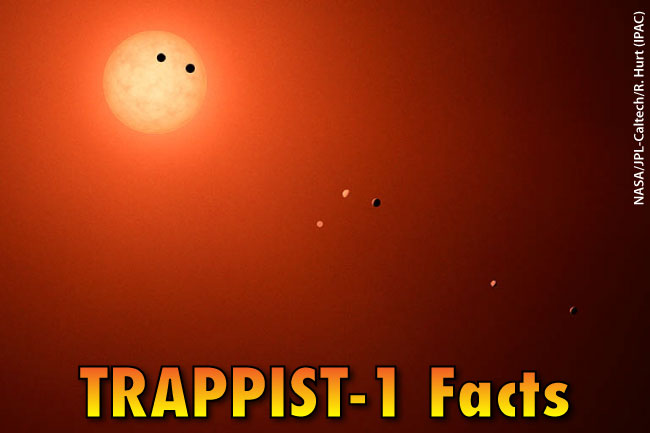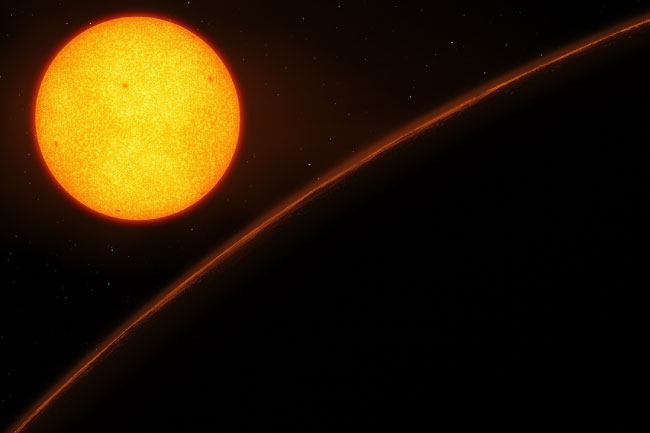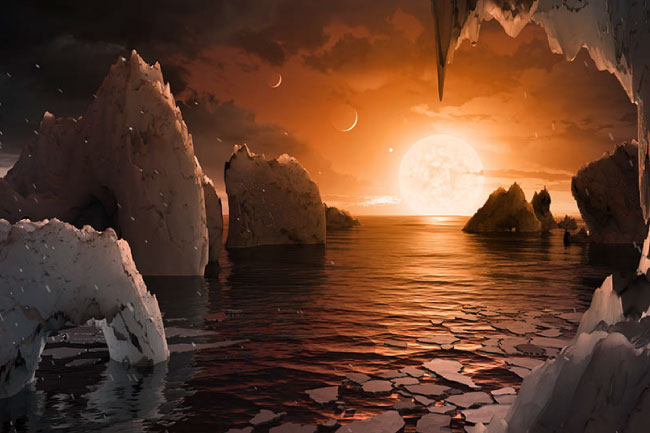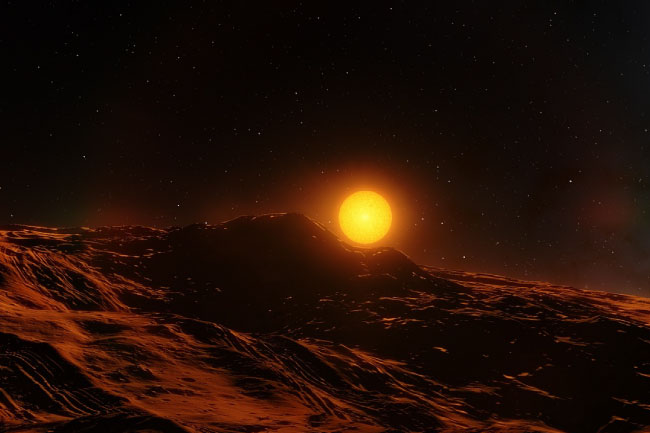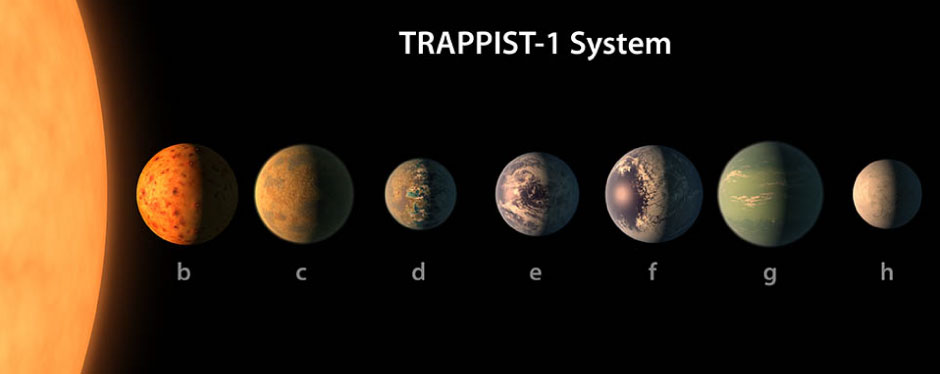TRAPPIST-1 facts for kids & students. The discovery of seven new planets could take us one step further towards finding out whether or not we're alone in the universe!
TRAPPIST-1 Facts: Introduction
In early 2017, NASA announced the discovery of seven Earth-sized rocky planets in orbit around a star that – in astronomical terms – isn’t very far away.
The planetary system was found by a robotic telescope, and further discoveries were made by a telescope in outer space.
As if that didn’t already sound too much like science fiction rather than 'science fact', NASA confirmed that three or more of the planets could potentially hold liquid water – one of the key ingredients for life!
On this page, you’ll discover facts about the star known as TRAPPIST-1, and the planets in orbit around it.
What Is TRAPPIST-1?
TRAPPIST-1 is a star in the Aquarius constellation around 40 light years away from Earth.
In early 2017, NASA (America’s space agency) announced that they had identified seven Earth-sized rocky planets in orbit around TRAPPIST-1.
Three of these planets are in orbit within TRAPPIST-1’s ‘habitable zone’. The habitable zone is the ‘sweet spot’ around a star that is neither too hot nor too cold for liquid water to exist on the surface of an orbiting planet.
Depending on atmospheric conditions, water may also be present on the four other planets in the TRAPPIST-1 system.
Why Is Water So Important?
Astronomers get very excited when they find planets that potentially have liquid water because it is a key factor in the formation of life.
Put simply, if there is liquid water on a planet, then there may also be life on the planet!
Ultra-Cool Dwarf Star
TRAPPIST-1 is what is known as an ‘ultra cool dwarf star’.
This doesn’t mean that it has the best nightclubs. Scientists use terms such as ‘red dwarf’, ‘supergiant’ and ‘ultra cool dwarf’ to describe different types of star.
Ultra cool dwarf stars are relatively small and cold, and don’t emit enough light to allow them to be seen with the naked eye.
Ultra-cool dwarf stars are only ‘cold’ in comparison to other types of star. The surface temperature of TRAPPIST-1 may be as high as 2,700 K (2,430 °C; 4,400 °F)!
However, compared to the Sun, which has a surface temperature of around 5,778 K (5,505 °C, 9,941 °F), TRAPPIST-1 is positively frosty!
In fact, TRAPPIST-1 is so dim and so red that even someone using a large amateur telescope would be unable to make it out.
In order to see TRAPPIST-1, you need some serious technology!
Where is TRAPPIST-1?
TRAPPIST-1 is in the Aquarius constellation.
A constellation is any one of the 88 regions into which the night sky – or ‘celestial sphere’ to give it its scientific name – is divided.
Aquarius doesn’t contain any particularly bright stars, and is quite tricky to make out. It is best seen from the Northern Hemisphere in the autumn, and from the Southern Hemisphere in spring.
How Far away is TRAPPIST-1?
Although in astronomical terms TRAPPIST-1 is relatively close to the Solar System, it’s still a long, long way away.
If you were thinking that we could just jump into a space shuttle to pay TRAPPIST-1 a visit, you might want to make other plans.
TRAPPIST-1 is 39.5 light years from the Sun.
A light year is the distance that light travels in one year. 39.5 light years is the same as 12.1 parsecs, or 3.74×1014 kilometers, or 2.32×1014 miles.
In non-scientific language, that’s around 232 trillion miles / 374 trillion kilometres away!
(One trillion = one million million.)
How Big is TRAPPIST-1?
TRAPPIST-1 has a radius of around 79,309 km, and a mass of around 1.59 x 1029 kg. Those figures may sound big, but in fact TRAPPIST-1 is small for a star.
TRAPPIST-1 is just over 1/10th of the size of the sun. Its mass is approximately 8% that of the sun.
In fact, TRAPPIST-1 is only slightly larger than Jupiter, the largest planet in our solar system. However, it is considerably more massive: TRAPPIST-1 has a mass of around 84 times that of Jupiter.
TRAPPIST-1 Planets
There are seven planets in orbit around TRAPPIST-1. They are all ‘terrestrial planets’, which means that they are made of rock and metal, rather than gas or ice.
In comparison, only four of the eight planets in the solar system are terrestrial planets. Of course, Earth is one of them.
All seven of TRAPPIST-1’s planets orbit TRAPPIST-1 more closely than Mercury orbits the sun. (Mercury is the closest planet to the sun.)
A year on the planet nearest to TRAPPIST-1 would last just 1.5 Earth days. Even on the sixth-furthest planet a year would take just 12.3 Earth days.
However, because TRAPPIST-1 is relatively cool, even planets in such close orbits to the star would be able to hold liquid water.
TRAPPIST-1’s planets are also very close to each other. An observer on one planet would be able to see clouds, oceans and perhaps even mountains on a neighboring planet.
Who discovered TRAPPIST-1 & Its Planets?
TRAPPIST-1 was discovered in 1999, as part of an astronomical survey of the whole sky. The survey was known as the ‘Two Micron All-Sky Survey’, or 2MASS for short. It was conducted by NASA in collaboration with US universities.
At first, TRAPPIST-1 was called ‘2MASS J23062928-0502285’.
The star was further studied by a team from the Université de Liège in Belgium, led by astronomer Michaël Gillon.
The team studied the star using the two Transiting Planets and Planetesimals Small Telescopes, located in Chile. These robotic telescopes are controlled from Belgium, and are known by abbreviated versions of their names: TRAPPIST North and TRAPPIST South.
Using TRAPPIST-South, Gillon’s team discovered three planets in orbit around the star. They were the first planets to be discovered by the telescope. Because of this, the star was named after the telescope.
After the discovery of the first three planets, NASA used the Spitzer Space Telescope – a telescope located in outer space – to study the TRAPPIST-1 system.
Spitzer, together with a number of ground-based telescopes, confirmed the presence of planets in orbit around TRAPPIST-1. It identified seven planets, and found that they were rocky, and Earth-sized.
TRAPPIST-1 Facts For Kids & Students: Conclusion
Does the discovery of the TRAPPIST-1 planetary system mean that we are no longer alone in the universe?
Not quite, but with many of Earth’s most powerful telescopes now being trained on the planets, they may reveal vital clues about the formation of life, and the possibility of life existing on other planets.
We hope that you have enjoyed reading about the discovery of TRAPPIST-1 and its seven planets. You can find more awesome science information in our science section.

